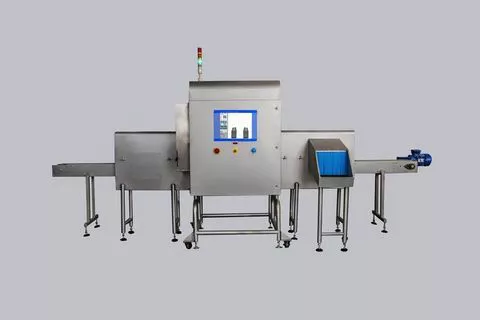Description
Metal detectors
Detects foreign objects by shielding products from their original metal components
There are many types of metal detectors, the earliest use of which dates back to the Second World War, when they were commonly known as 'mine detectors' and used the difference in physical properties between the mine and the surrounding soil, such as the dielectric constant, to cause aberrations in the microwave electromagnetic field radiated by the mine detector, and to determine the location of the mine by detecting the aberrated field signal.
Today, this type of equipment is used in a variety of different areas, such as security gates for airports and handheld metal detectors.
Metal detectors for industrial applications are precision detection devices for the removal of metallic [1] foreign body contamination.
Metal detectors are used to detect metallic foreign bodies mixed in the production of food, pharmaceuticals, chemicals, textiles, etc. The principle is a central transmitting coil and two reciprocal receiving coils, which are mounted in a detector head. The oscillator emits a high frequency magnetic field through the central transmitting coil, which is connected to the two receiving coils, but with opposite polarity, so that they produce voltage output signals that cancel each other out when the magnetic field is not disturbed by the outside world. Once metal impurities enter the magnetic field area, this balance is disturbed and the induced voltages from the two receiver coils cannot be cancelled out. The uncancelled induced voltage is amplified and processed by the control system and the metal detector detects the presence of metal and generates an alarm signal (metal impurities detected). The system can then use this alarm signal to drive an automatic reject device, for example, to remove the metal contamination from the production line.
The accuracy and reliability of the metal detector depends on the stability of the electromagnetic transmitter frequency, which generally operates from 80 to 800 kHz. The lower the operating frequency, the better the detection performance for iron; the higher the operating frequency, the better the detection performance for high carbon steel. The sensitivity of the detector decreases as the detection range increases and the size of the sensed signal depends on the metal particle size and conductivity.
- Metal detectors
Production Capacity:
Not informed
Delivery Timeframe:
Within 45 Days
Incoterms:
FOB - Free on Board
Packaging Details:
Not informed
More about
STeps Detek technogloy (shanghai)
10-50
Employees
100K - 200K
Sales volume (USD)
20%
% Export sales
Year
Established
Business type
- Industry / Manufacturer
Keywords
- Xray inspection machine
Contact and location
-
Melody ********
-
+86 1********
-
shanghai / Shanghai CHina | China






